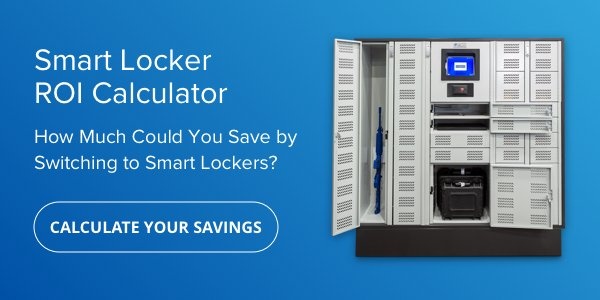By Jay Palter | April 14, 2021
Smart storage systems are transforming how high-security organizations manage all types of different assets. That includes firearms and less-than-lethal weapons too.
How can smart lockers help with weapons management? What are smart lockers anyway? And what should you look for if you want to purchase a smart weapon storage locker for your organization? Let’s find out.
Common Weapons Management Headaches
Manual weapons management works well for smaller organizations, but the process doesn’t scale very well. Law enforcement agencies and other high-security organizations with larger weapons pools will see the overhead costs from manual management snowball as their weapons inventory grows.
Those organizations commonly encounter one or more of these issues:
Inefficient distribution
Logging and distribution alone can take up an armory manager’s entire day. Tracking firearms and less-than-lethal (LTL) weapons by hand also increases the chance for human error to lead to costly accidents or losses.
A weapons manager could distribute a handgun from their shared pool to a deputy but forget to record the transaction. They could fail to log whether a regulated OC spray (pepper spray) canister was used when an officer returned from their patrol. They could accidentally distribute an LTL weapon to someone who hadn’t gone through the most recent round of weapons training.
A reliable weapons tracking program should record:
- Who has which weapons
- When staff will return those weapons
- When they have been used
- When they were last serviced
Difficulty maintaining an audit trail
Local and federal agencies continue to add new tracking requirements for uses of force. Manual tracking processes may not provide timely insights to comply with these regulations.
Poor accountability
Weapons managers need a way to keep accountable the officers, guards, and anyone else signing out weapons from a shared pool. When any staff member returns a shared asset late, it lowers the effectiveness of the entire organization. When that asset is a weapon, that decreased effectiveness can have life-threatening consequences.
Weak physical security
In high-security environments, unsecured weapons are a serious liability. Organizations need to keep unused firearms and LTL weapons in a durable storage system with strong access controls in place.
The storage system needs to prevent brute-force attempts to steal weapons. Access controls are necessary to deter social engineering attacks where attackers deceive weapons managers or other authorized staff into distributing weapons. Storage systems also need methods for preventing more common accidental losses.
Smart weapon storage lockers can solve all of these challenges.
Smart Lockers
Smart lockers are storage systems with integrated computer access controls and sensor systems. Smart lockers use those sensors, along with information collected from transaction logs, to monitor their performance. They can take action based on the criteria you set. For example, they can change which weapons are available to sign out, flag weapons in need of servicing, and alert supervisors to irregularities in signout patterns.
Access control terminals can accept various authentication methods, including biometrics, such as fingerprints or iris eye scans, RFID tokens, swipe cards, or PINs. You can use touchscreen access terminals to guide weapon selections or require personnel to run through checklists at sign-out or return so that they log everything your organization is required to document about weapons transactions.
Smart lockers use content surveillance tools to monitor the status of assets stored in their compartments. For monitoring weapons, smart lockers can use embedded, wireless RFID chips and sensors. These sensors verify that the correct weapon is taken or returned when a staff member logs a transaction.
Specialty surveillance tools are also available. For example, scales inside lockers can weigh OC spray cans to check whether they were discharged. For added accountability, cameras on the access terminals can log a picture of the user signing a weapon in or out.
Smart lockers automate many time-consuming aspects of weapons management, such as logging transactions, reporting, and monitoring signed-out weapons for late returns or other issues. Armory managers will have more time to focus on weapons servicing, procurement, and long-term planning.
7 Smart Locker Features That Support Better Weapons Management
If you’re evaluating different weapon storage lockers for your organization, make sure they have these seven features. Each is essential for better weapons management.
1. Sturdy design
Weapons lockers need to stand up to use in high-traffic environments. They also need to be strong enough to withstand brute-force attacks; 18-gauge steel is the standard for secure storage solutions for critical assets, such as firearms and LTL weapons.
2. Modular
No two organizations have the same weapons management needs. Your mix of handguns, long guns, and LTLs is different than any other agency’s. So if a weapon storage locker claims to be one-size-fits-all, that means it actually fits nowhere.
Modular locker systems can connect different-sized compartments into a management system that fits your specific weapons inventory and physical space constraints. They can also scale up or down in capacity if your needs change over time.
3. Content surveillance
Content surveillance is one of the critical tools that make a locker system “smart.” You can tag high-value firearms or regulated weapons so they can be scanned at sign-out or return for extra accountability.
4. Access control
Ideally, your weapon storage lockers should use the same electronic access control you employ elsewhere in your facility. Integrating your access control will simplify use as staff won’t need to learn two different systems. It will also reduce overall management costs as you don’t need two separate management consoles running on different IT infrastructure.
5. Smart management
Look for smart lockers that can automate essential workflows. For example, a smart weapons locker system could prompt personnel to report any service issues when they sign a weapon in or out.
When they report an issue, the locker system can prompt them to deposit the weapon in a specially designated service locker and send a text or email alert to the armory manager. Instead of relying on the reporting officer to track down the armory manager or remember to send them an email when they get back to their desk, the locker system itself automates the entire process.
6. Reporting
A good locker system should automate most of the usage reporting high-security organizations need to conduct on their weapons. For example, most equipment purchased through federal grants requires some level of documentation for compliance. Good reporting also helps track firearm losses and thefts when those incidents need to be reported to the Bureau of Alcohol, Tobacco, Firearms and Explosives (ATF).
7. Service & support
Smart locker systems simplify weapons management, but they are still complex technology. You want to find a system provider who will be able to respond to urgent needs in your high-security environment. Evaluate provider service plans and the type of support they can offer. Will they come on-site, or do they only offer phone and email support?
Other Assets That Benefit from Smart Lockers
One of the major advantages of using smart lockers for storage is that they can accommodate a wide range of equipment. If you’re looking for weapon storage lockers, consider what other assets might benefit from smart management.
Electronic device support
Smart lockers can come equipped with built-in charging ports for mobile devices, such as laptops and tablets. These lockers should be well ventilated to protect devices from overheating. You may also want to look for lockers with wired USB connections for content surveillance.
Other police gear
Smart lockers are also practical tools for managing other police gear that you want to track, including two-way radios, body cams, dash cams, and radar kits. Most police-grade radios now come equipped with an RFID socket for content surveillance tracking. You can tag each component in a radar kit so the locker system can confirm each component is accounted for at sign-out and return.
Evidence management
Smart lockers can automate the meticulous process of evidence logging and storage. Because every sign-out is tracked, you will always have a complete chain-of-custody record. While you won’t want to use the same locker set for weapons and evidence management, you can use the same management portal to track usage across all of your locker systems.
Integration with other systems
Smart management systems are designed to integrate. For example, you can use a single, unified management platform for tracking both police gear and key rings. You’ll be able to confirm in real time which personnel have signed out which key rings, when they are expected to return them, and what keys are overdue.
Reliable Weapons Management with Smart Lockers
If your high-security organization has weapons it needs to store and track, there is a good chance that a smart locker system is the right solution. Smart lockers for weapons storage provide better security and keep staff more accountable. They’re a cost-effective solution no matter if you have dozens or hundreds of weapons to manage.
Want to determine whether a smart locker system is worth the investment? Try out our Smart Locker ROI Calculator today.
Subscribe to our blog

Jay Palter
Vice President of Marketing & Partnerships






